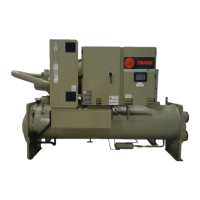68
RTHD-SVX01L-EN
Table 16, p. 68 and list baseline measurements for
Optimus™ units running at AHRI standard operating
conditions. If chiller measurements vary significantly from
values listed below, problems may exist with refrigerant
and oil charge levels. Contact Trane service.
Table 16. Operating conditions at full load
Description
Condition
Evaporator pressure 40-55 psig
Condensing pressure 85-120 psig
Discharge superheat
17°F
Subcooling
5-10°F
EXV percent open 40-50% open in Auto mode
Note: All conditions stated above are based on the unit running fully
loaded at AHRI conditions. If full load conditions cannot be met,
contact Trane service.
Table 17. Operating conditions at minimum load
Description
Condition
Evaporator approach
less than 7°F
(a)
(non-glycol
applications)
Condensing approach
less than 7°F
(a)
Subcooling
2-3°F
EXV percent open 10-20 % open
Note: Conditions at minimum must be: entering condenser water: 85°F
and entering evaporator water: 55°F
(a)
~1.0°F for new unit.
Maintenance Procedures
Cleaning the Condenser
NOTICE
Proper Water Treatment Required!
The use of untreated or improperly treated water
could result in scaling, erosion, corrosion, algae or
slime.
Use the services of a qualified water treatment
specialist to determine what water treatment, if any, is
required. Trane assumes no responsibility for
equipment failures which result from untreated or
improperly treated water, or saline or brackish water.
Condenser tube fouling is suspect when the “approach”
temperature (i.e., the difference between the refrigerant
condensing temperature and the leaving condenser water
temperature) is higher than predicted.
Standard water applications will operate with less than a
10°F approach. If the approach exceeds 10°F, cleaning the
condenser tubes is recommended.
Note: Glycol in the water system typically doubles the
standard approach.
If the annual condenser tube inspection indicates that the
tubes are fouled, two cleaning methods can be used to rid
the tubes of contaminants. The methods are:
Mechanical Cleaning Procedure
Mechanical tube cleaning this method is used to remove
sludge and loose material from smooth-bore condenser
tubes.
WARNING
Heavy Object!
Failure to follow instructions below could result in
unit dropping which could result in death or serious
injury, and equipment or property-only damage.
Ensure that all the lifting equipment used is properly
rated for the weight of the unit being lifted. Each of the
cables (chains or slings), hooks, and shackles used to
lift the unit must be capable of supporting the entire
weight of the unit. Lifting cables (chains or slings)
may not be of the same length. Adjust as necessary
for even unit lift.
WARNING
Straight Vertical Lift Required!
Failure to properly lift waterbox in straight vertical lift
could cause the eyebolts to break which could result
in death or serious injury from object dropping.
The proper use and ratings for eyebolts can be found
in ANSI/ASME standard B18.15. Maximum load rating
for eyebolts are based on a straight vertical lift in a
gradually increasing manner. Angular lifts will
significantly lower maximum loads and should be
avoided whenever possible. Loads should always be
applied to eyebolts in the plane of the eye, not at
some angle to this plane.
Waterbox Removal
Review mechanical room limitations and determine the
safest method or methods of rigging and lifting the
waterboxes.
Important:
• Do not rotate water boxes. See Figure 14,
p. 29 through Figure 16, p. 30 for correct
orientation of the water inlet and outlet.
• Be certain to replace water boxes right-
side-up to maintain proper baffle
orientation. Use new o-rings.
1. Determine the size of chiller being serviced. See unit
nameplate located on chiller control panel.
2. Select the proper lift connection device from . The rated
lifting capacity of the selected lift connection device
must meet or exceed the published weight of the
waterbox found in .
3. Ensure the lift connection device has the correct
connection for the waterbox. Example: thread type
(course/fine, English/metric). Bolt diameter (English/
metric).
Maintenance

